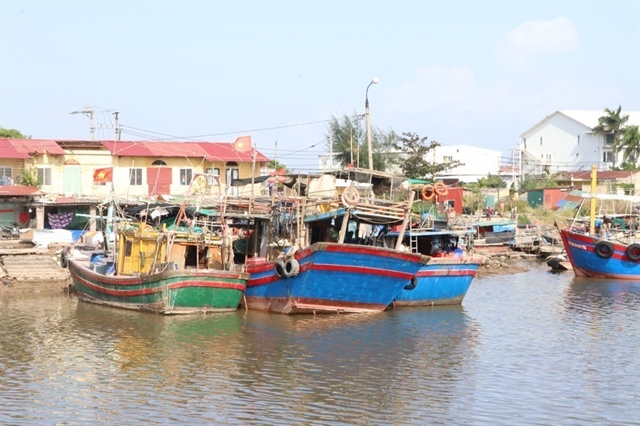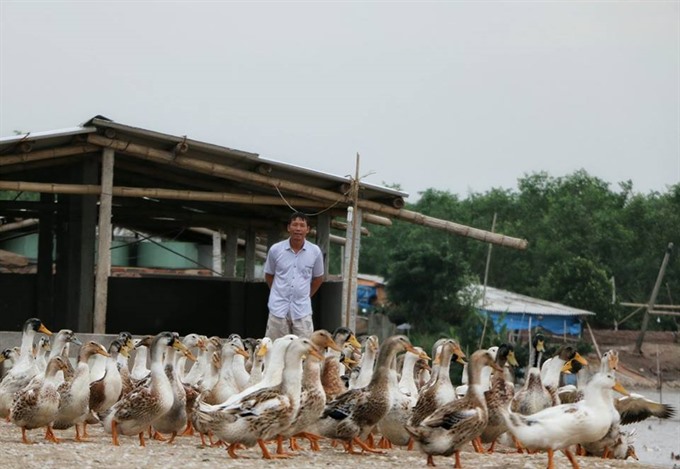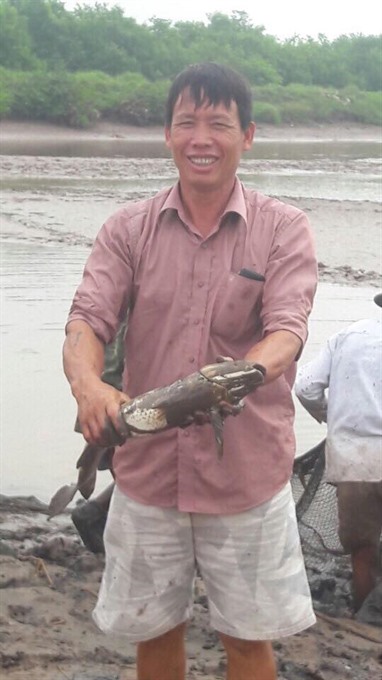 Society
Society

Đoàn Văn Vươn has gone through ups and downs, working on his land to turn his farm into the largest one in the region.
 |
Đoàn Văn Vươn with his flock of ducks at the farm that he single-handedly raised, painstakingly, over many years. A violent response to a controversial takeover landed him jail, but his right to continue farming the land was recognised by the Government. — VNS Photo Đoàn Tùng |
by Thu Vân
HẢI PHÒNG – When she was young and in love, Thương and her boyfriend often went to the beach near their hometown. He would always point along the shore and say he would turn the area into a swampland for raising fish and shrimp.
“How crazy is that!” she would think to herself, but tell him that she would back him all the way.
Their hometown, a small village in Tiên Lãng Distrist on the outskirts of Hải Phòng City, was often hit by storms and floods, and locals had several times fled in panic, leaving behind their land and property.
The Government had carried out a study back then, and one of its recommendations was to push the national dyke further inland to ensure the safety of locals.
Thương’s boyfriend, later her husband, showed her that as crazy as he seemed, he was also a man of his word.
Đoàn Văn Vươn, who served in the army in the early 1980s, returned and enrolled at the Hà Nội University of Agriculture in 1987, specialising in agronomic pedology, the science of soil and erosion.
In 1993, Hải Phòng called for private investment to develop the economy and started renting land to individuals.
Vươn took the plunge and asked to rent 21 hectares of land to produce seafood.
But first, he wanted to build a dyke to protect the area, which was often hit by storms. The idea was to also to divert the local river’s waters to help create layers of alluvial soil, where he could later engage in aquaculture.
Most people dismissed the idea as “impractical” and “crazy.”
“The local agriculture department rejected the proposal and thought I had a mental problem,” Vươn recalled.
Undaunted, he met with the head of the concerned department to try and persuade him.
“He asked me if I had enough money to build the dyke, and I said yes,” Vươn said, although he knew he would have to borrow lots of money.
Braving the odds
Starting in 1994, Vươn hired 12 vessels to transport rocks and earth to where he wanted the dyke built. It was a long and windy road to the site.
“If the weather was good, we could build a part of the dyke, each day. But how far we got depended on what happened overnight. If the tide was low, two-thirds of the part would survive, if the tide was high, only a third would be left,” he said.
There were days when the stones and soil put in place in the morning would be totally gone by noon.
Vươn went crazy trying to find a solution. He would wander around or sit on the seashore the whole day, the whole week, even, just to see how the tide was behaving.
There were times when he would rush to the seashore on his bike the moment he heard the sound of afternoon waves hitting the shore.
“Of course people and even my family said I was crazy. But I like to test my limit, I like to take the tough road,” he said.
In February, when the weather gets dry and the tide is low at night, he knew he had to act fast. He hired many contractors at the same time to build the dyke, with each contractor building his section fast enough so that it could dry through the night.
There were times when some 750 workers swarmed the construction site.
By 1995, the 2km long dyke was completed, and the locals were amazed. A vast swampland of several dozen hectares had been created.
Vươn then began work on planting a barrier of trees to provide additional protection from the elements. By 2001, he had created a whole swamp with a forest as barrier against the waves. It had taken him eight years to do this. The deadly swamp in a high-risk zone had become productive land shielded by a solid dyke.
 |
Vươn with a fish bred on his farm. After a tumultuous period, he just wants to focus on making “clean products my trademark.”. — VNS Photo Đòan Tùng |
Losing everything
The heroic farmer who battled nature for years to fulfill his vision had to pay a heavy price.
Apart from the blood and sweat and money that went into his project, he had also lost his first child, a daughter who drowned in a pond while the parents were out tending to the fish.
Then came a harrowing time when the local administration decided that the farm he’d worked so hard to create would be taken back from him. The year was 2012.
After building the dyke, Vươn had asked to rent another 19 hectares and his requested was accepted by local authorities. The lease would last 14 years.
In 2011, Tiên Lãng authorities issued a decision to take back all the land that Vươn had been using without any compensation. Vươn petitioned the court, which never responded.
On January 5, 2012, when the authorities came to seize the land, Vươn and his family resisted. They erected three barriers around the land, set off homemade mines, and open fire on the police.
Six officers were injured.
Vươn and three other members of the family were detained and later charged with attempted murder.
But his plight had not gone unnoticed by the rest of the nation as well as the central Government.
After listening to all sides of the story and looking at the evidence, then Prime Minister Nguyễn Tấn Dũng ordered that the Hải Phòng administration should stick to regulations and allow Vươn to continue using the allocated land.
He also ordered all cities and provinces to pro-actively review and adjust land management to ensure that all land revocation was legal and fair. New land laws should be formulated to suit the new situation, he said.
Vươn had to spend more than three years in jail. But he has no regrets.
“It was my livelihood. I would die for it. Without the land, I have nothing. Without land, a farmer has nothing,” Vươn said.
He was released on August 31, 2015 for good conduct.
Another comeback
Standing by the pond in his farm as thousands of ducks quacked away on a sunlit afternoon, Vươn looked just like any other farmer in his blue shirt and light-coloured trousers.
With a bright smile on his face that belied the struggles he’d been through, he said all he wants to do now is to work on his land.
Just a week after he returned, Vươn started working to realise the promise he’d made to his wife. He would turn his farm into the largest one in the area.
A friend happened to give him a hundred seaducklings. After a month, he bought another thousand of them. A year later, his flock has grown to 7,000 seaducks.
Vươn makes the feed for the ducks by himself. He says this is what makes its meat tasty.
“Normally people sell their ducks after 45 to 50 days. I wait until the ducks are 90 days old. After the first 60 days, I adjust their diet so that the ducks lose their fat,” Vươn said as he fed the ducks with his homemade feed.
Pointing to the ponds where the ducks were swimming, he said he was also raising shrimp. The farm’s products, ducks, duck eggs and shrimp have been sold to a number of organic food shops across the country.
Vươn said he plans to increase the number of ducks to 10,000 soon. He is also working on a small workshop so that others can buy his homemade feed.
“As a farmer, I understand the worries of the customer about food hygiene and safety. I’m working on it,” Vươn said.
In May this year, Vươn organised a small ceremony to introduce his Vườn Biển products, including all the organic seafood grown on his farm. He was able to sign contracts with several many food suppliers and restaurants in Hà Nội and other areas.
There’s no doubt he will succeed. All the ducks are set to be bought by the time they are 90 old, even pre-ordered.
Vươn is content.
“All the sad chapters in my life are over. Now I want to focus on my farm and make clean products my trademark.” — VNS




